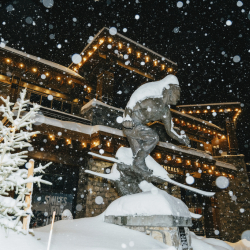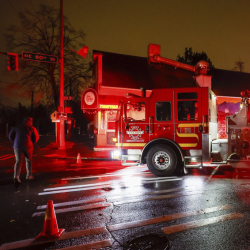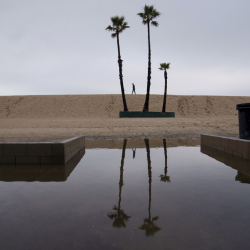 PORT-AU-PRINCE, Haiti (AP) — Hurricane Tomas flooded the earthquake-shattered remains of a Haitian town on Friday, forcing families who had already lost their homes in one disaster to flee another. In the country's capital, quake refugees resisted calls to abandon flimsy tarp and tent camps.
PORT-AU-PRINCE, Haiti (AP) — Hurricane Tomas flooded the earthquake-shattered remains of a Haitian town on Friday, forcing families who had already lost their homes in one disaster to flee another. In the country's capital, quake refugees resisted calls to abandon flimsy tarp and tent camps.
The Skanner News Video here
Driving winds and storm surge battered Leogane, a seaside town west of Port-au-Prince that was near the epicenter of the Jan. 12 earthquake and was 90 percent destroyed. Dozens of families in one earthquake-refuge camp took their belongings through thigh-high water to a taxi post on high ground, waiting out the rest of the storm under blankets and a sign that read "Welcome to Leogane."
"We got flooded out and we're just waiting for the storm to pass. There's nothing we can do," said Johnny Joseph, a 20-year-old resident.
The storm, once again a hurricane with 85 mph (135 kph) winds, was battering the western tip of Haiti's southern peninsula and the cities of Jeremie and Les Cayes.
One man drowned while trying to ford a river in an SUV in the rural area of Grand-Anse, said civil protection official Pierre Andre. The hurricane had earlier killed at least 14 people in the eastern Caribbean.
The center of the storm was 157 miles from Port-au-Prince, draping charcoal clouds over the city and dropping a steady rain with occasional bursts of wind. There were no immediate reports of damage.
The U.S. National Hurricane Center in Miami predicted dangerous storm surges along the coast and possible flash floods and mudslides in mountainous areas.
Haiti's civil protection department had urged people living in camps for the 1.3 million Haitians made homeless by the Jan. 12 earthquake to go to the homes of friends and family.
By evening it was clear most camp residents were not heeding the advice. People in the yard of a high school on the Delmas 33 thoroughfare in Port-au-Prince said their camp's governing committee had passed along the official advice to leave, but they decided to stockpile water and tie down their tents instead.
Buses began circulating around the camps just after dark Thursday night to take residents away, but few were willing to go. Four civil protection buses that pulled up at a camp in the Canape-Vert district left with about five passengers on them.
Many camp residents stayed put out of fear they would lose their few possessions and, worse, be denied permission to return when the storm was over.
"I'm scared that if I leave they'll tear this whole place down. I don't have money to pay for a home somewhere else," said Clarice Napoux, 21, who lives with her boyfriend on a soccer field behind the St. Therese church in Petionville. They lost their house to the quake and their only income is the little she makes selling uncooked rice, beans and dry goods.
Late Thursday, Tomas passed to the east of Jamiaca, where earlier schools closed in eastern provinces and traffic was jammed in the capital, Kingston, as businesses closed early.
"I'm taking no chances," said Carlton Samms, a bus driver who went home early after stopping at a supermarket for food and other supplies.
The storm was expected to cross over Haiti's southwestern tip, then swirl through the strait that divides Haiti from Cuba.
At the U.S. Navy base at Guantanamo Bay in southeastern Cuba, the military cleared away any debris that could fly off in strong winds, suspended flights, canceled school and closed the harbor to recreational craft.
"We have a well-rehearsed plan that is going to serve us well," said Navy Cmdr. James Thornton, Guantanamo Bay's operations officer.
Early Friday, the hurricane was located about 160 miles (255 kilometers) west of Port-au-Prince and 80 miles (130 kilometers) south-southeast of Guantanamo, Cuba. It was moving to the northeast at about 10 mph (16 kph). Tropical-storm-force winds extended as far as 140 miles (220 kilometers) from the center.
Forecasters warned of a dangerous storm surge that would generate "large and destructive waves" and raise water levels up to 3 feet (nearly 1 meter) above normal tide levels. It also predicted rainfall of 5 to 10 inches (12 to 25 centimeters) for much of Haiti and the Dominican Republic, which share the island of Hispaniola.
Port-au-Prince's airport was expected to be closed through Friday, American Airlines spokeswoman Mary Sanderson said.
Most of Haiti's post-quake homeless live under donated plastic tarps on open fields. It is often private land, where they have been constantly fighting eviction. A September report from U.N. Secretary-General Ban Ki-moon said 29 percent of 1,268 camps studied had been closed forcibly, meaning the often violent relocation of tens of thousands of people.
Haitian human-rights lawyer Mario Joseph, who testified on behalf of those evicted before the Inter-American Commission on Human Rights this summer, said he fears the government is using the storm as an excuse to drive people off disputed land.
"I think it's going to be a time of eviction," he said. He said he has advised people who know they are at risk for floods, landslides and wind damage to stay in buildings near the camp and return to their squatters' sites as soon as possible after the storm.
Reconstruction has barely begun and even the building of transitional shelters — sturdier than makeshift tents, but not solid houses — has been slow. Large installments of long-term funds, including a promised $1.15 billion from the United States, have not arrived. The State Department now says it still has to prove the money won't be stolen or misused.
"We know that, particularly with flooding and mudslides, there's going to be a loss of life. It's inevitable. But we will be prepared to do everything that we can to meet the immediate needs of the Haitian people," State department spokesman P.J. Crowley said Thursday.
As rebuilding lags, the United Nations and aid groups have been giving people reasons to stay in camps, providing aid and essential services such as medicine. That continued Thursday as residents reluctant to leave were given reinforcing tarps and other materials.
"We have always said that the best way to protect people in camps is to make camps as resistant as possible to any weather," said Imogen Wall, spokeswoman for the U.N. Office for the Coordination of Humanitarian Affairs. "(Evacuation) doesn't make sense ... on a practical level, on a large scale."
Residents of the nearly 8,000-person government relocation camp at Corail-Cesselesse threw bottles at aid workers trying to get them to leave their ShelterBox tents for schools, churches and an abandoned prison nearby.
"If we go away, other people are going to move in our place! We want to stay here because we don't have another place to go," said 29-year-old Roland Jean.
The camp's grounds were designed by U.S. military engineers and graded by the United Nations. But the selection of the site has been criticized by aid groups almost since the beginning: The desert plain nine miles (15 kilometers) north of the city constantly floods and suffers wind damage.
Residents were told the tents could resist hurricanes. ShelterBox spokesman Tommy Tonkins said Thursday that they can stand up to heavy rains and 75 mph (120 kph) winds, but are not hurricane-proof.
Camp officials finally resolved the dispute and several hundred people left Thursday afternoon on trucks provided by U.N. peacekeepers. An AP reporter found that while the school, church and abandoned hospital chosen as shelters for them were large and undamaged, they had no water or usable toilets.
Tomas killed at least 14 people when it slammed the eastern Caribbean country of St. Lucia as a hurricane Saturday. It will cost roughly $500 million to repair flattened banana fields, destroyed houses, broken bridges and eroded beaches on the island, Prime Minister Stephenson King announced Thursday.
Associated Press television producer Chris Gillette and writers Jacob Kushner in Croix-des-Bouquets, Evens Sanon in Port-au-Prince, Howard Campbell in Kingston, Jamaica, and Guy Ellis in Castries, St. Lucia, contributed to this report.
Portland and Seattle
Free Subscription to Breaking News
Free Subscription to Breaking News






















































































































































































































































































































































